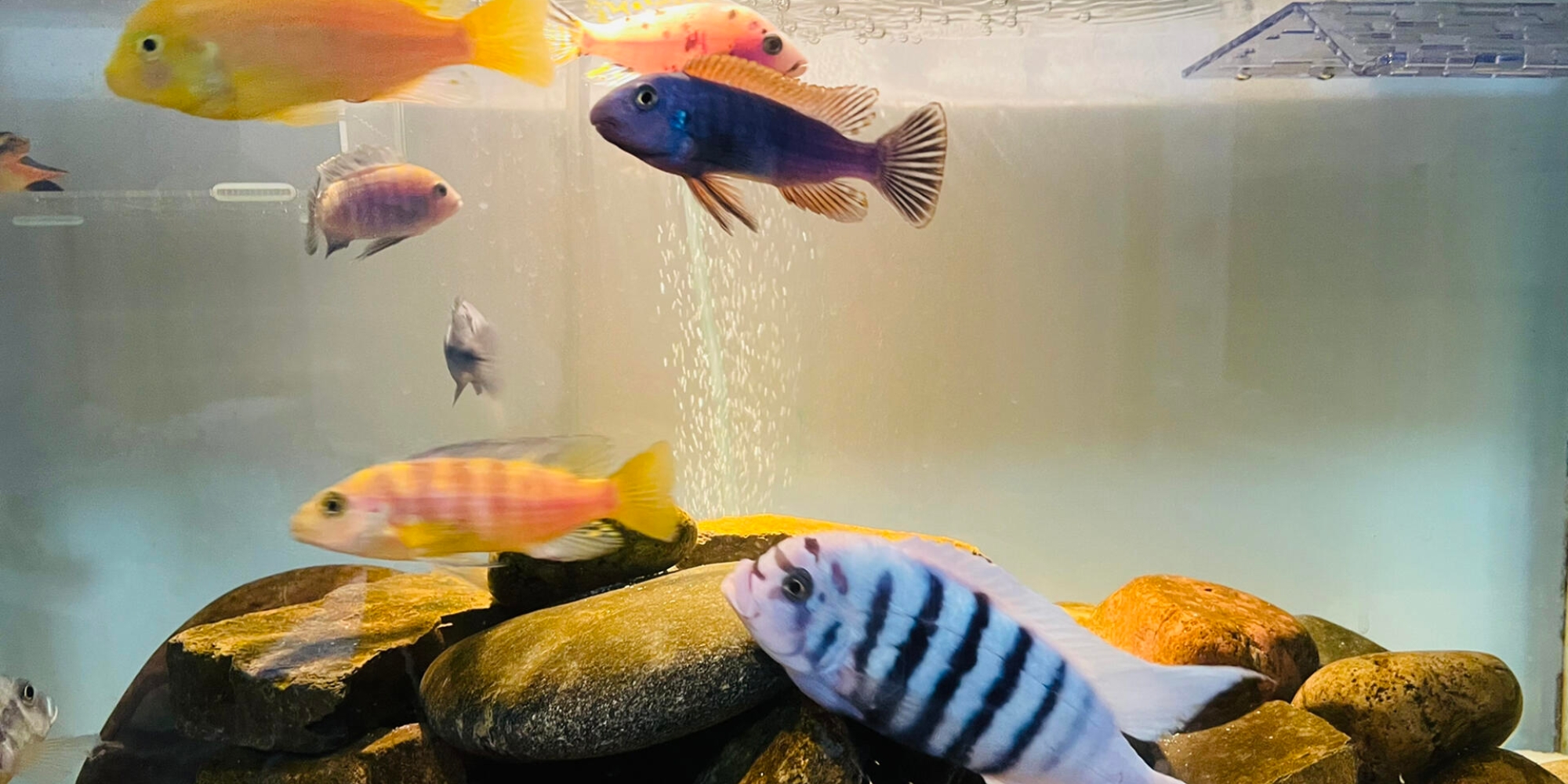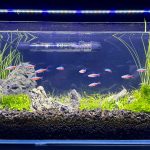Cichlids are some of the most popular freshwater fish for aquarium lovers, and for good reason!
They come in every color of the rainbow, have big personalities, and can range from peaceful community fish to bold, bossy tank rulers.
Whether you’re a newbie or a seasoned fishkeeper, there’s a cichlid out there for you. But to keep them happy and healthy, you’ll need to nail the basics: the right tank setup, clean water, and a diet that matches their needs.
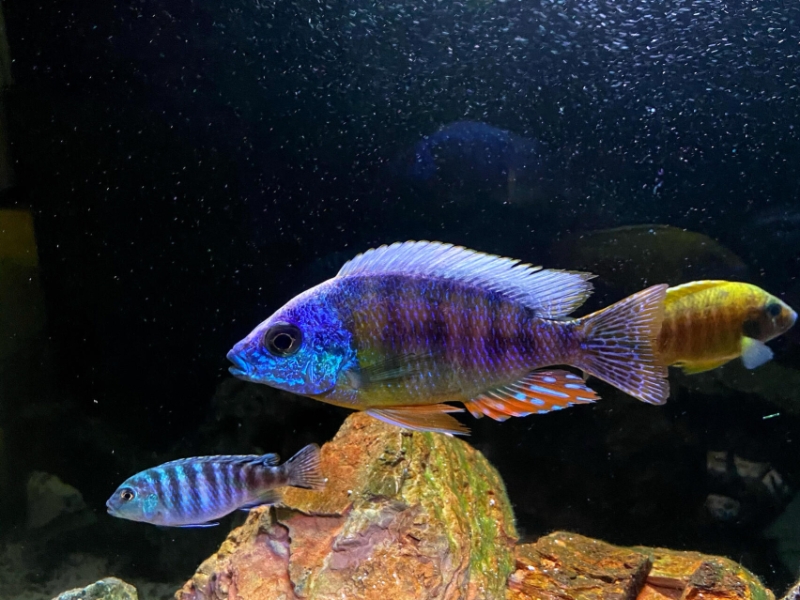
Choosing the Right Cichlid for You
Not all cichlids are the same, so picking the right type is key. Here’s a quick breakdown:
- Beginner-friendly cichlids: German Blue Rams and Kribensis are small, colorful, and less aggressive. Perfect for tanks as small as 20 gallons.
- Feisty showstoppers: African cichlids (like Peacocks) and Oscars are stunning but need bigger tanks (55+ gallons) and careful planning to manage their territorial streaks.
- Peaceful community types: Angelfish and Keyhole Cichlids play nice with others if given enough space.
Pro tip: Research your species before buying. A happy cichlid starts with the right match!
Setting Up the Perfect Cichlid Tank
Cichlids are picky about their homes. Here’s how to keep them thriving:
1. Tank Size Matters
- Small cichlids (like Apistogramma): 20-30 gallons.
- Medium species (like Firemouths): 40-55 gallons.
- Big guys (Oscars, African cichlids): 75+ gallons.
2. Must-Have Gear
- A beefy filter: Cichlids are messy eaters. Go for a canister filter or a hang-on-back model rated for a tank larger than yours.
- Heater: Most cichlids prefer 75-80°F. Adjustable heaters are worth the extra cost.
- Substrate: Use sand for digging species (like African cichlids) or smooth gravel for others.
3. Decor That Works
- Rocks and caves: Stack slate or lava rocks to create hiding spots and territory lines.
- Avoid live plants (mostly): Many cichlids love to dig or nibble. Fake plants or tough species like Java Fern are safer bets.
Water Quality: Keep It Clean, Keep It Stable
Cichlids are sensitive to dirty water, so consistency is key:
1. Know Your Water Type
- African cichlids (Lake Malawi/Tanganyika): Hard, alkaline water (pH 7.8-8.5). Crushed coral in the filter helps.
- South American cichlids: Soft, slightly acidic water (pH 6.5-7.0). Driftwood naturally lowers pH.
2. Maintenance Routine
- Change 15-20% of the water weekly.
- Test pH and ammonia levels monthly (kits are cheap and easy to use!).
- Red flags: Cloudy water, fish gasping at the surface, or faded colors mean trouble. Act fast!
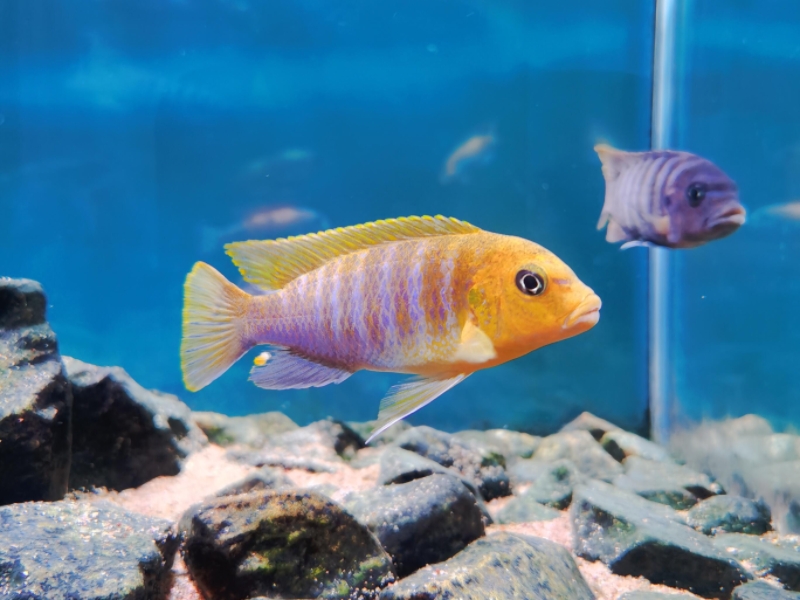
Feeding Your Cichlids: What’s on the Menu?
Cichlids aren’t fussy eaters, but they do need the right balance:
1. Match the Diet to Your Fish
- Meat lovers (Oscars, African cichlids): High-protein pellets, frozen shrimp, or bloodworms.
- Veggie fans (Tropheus, some South American species): Spirulina flakes, blanched spinach, or algae wafers.
- All-rounders (Angelfish, Rams): Mix flakes, pellets, and occasional live/frozen treats.
2. How Much and How Often?
- Adults: Feed 1-2 times daily, only what they can finish in 2 minutes.
- Juveniles: 3-4 small meals a day for growth.
3. Foods to Skip
- Live goldfish: They’re not nutritious and can spread diseases.
- Bread or rice: Fills them up but offers zero nutrition.
- Old/expired food: Nutrients break down over time.
Fun fact: Some cichlids recognize their owners and get excited at feeding time—try hand-feeding pellets for a cool bonding moment!
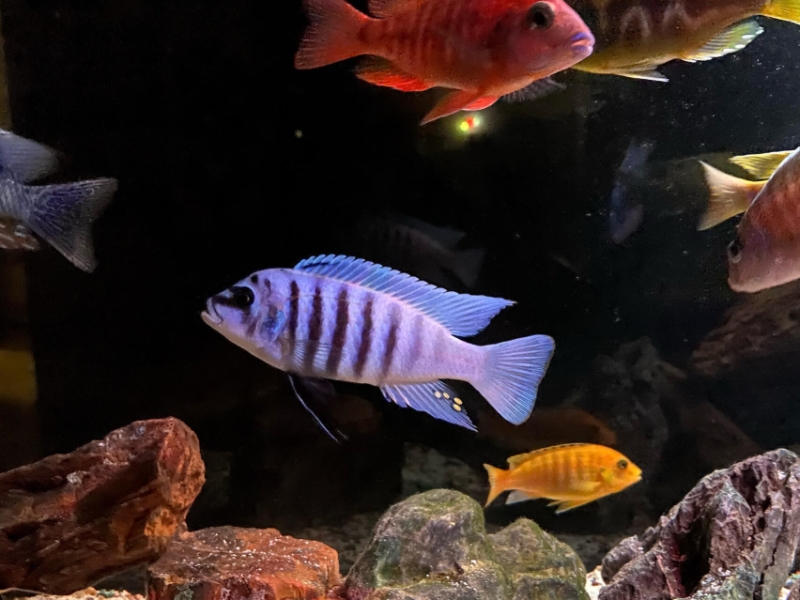
Dealing with Cichlid “Drama”: Aggression and Tank Mates
Let’s face it—cichlids can be the divas of the aquarium world. They’re smart, territorial, and sometimes downright feisty. Here’s how to keep the peace:
1. Picking Roommates Wisely
- Safe bets:
- Larger tetras (like Congo Tetras).
- Catfish (Plecos or Synodontis).
- Fast swimmers (Silver Dollars or Rainbowfish).
- Avoid: Tiny fish (neon tetras, guppies) – they’ll become expensive snacks.
2. Tank Layout Tricks
- Break up sightlines: Use rocks, driftwood, or tall plants to create “zones.”
- Overstock (carefully!): More fish = less targeting of individuals. Works best in big tanks with strong filtration.
- Have a backup plan: Keep a spare tank or divider ready for bullies.
3. Signs of Trouble
- Chasing that never stops.
- Fish hiding 24/7 or missing scales.
- One fish hogging all the food.
Pro tip: Rearrange decorations weekly to reset territories. It’s like hitting a “reset” button on squabbles!
Breeding Cichlids: From Eggs to Babies
Breeding cichlids is half science, half magic. Here’s how to boost your odds:
1. Setting the Mood
- Water tweaks: Slightly warmer temps (2-3°F increase) and extra clean water.
- Privacy please: Move a pair to a dedicated breeding tank (20+ gallons).
- Egg-friendly surfaces: Flat stones, clay pots, or even a tilted slate tile.
2. The Parenting Journey
- Egg stage: Parents guard fiercely. Don’t disturb them!
- Hatching: Fry (baby fish) stick to parents or the spawning site for 3-5 days.
- First foods: Powdered fry food, baby brine shrimp, or crushed flakes.
3. When Things Go Wrong
- Eggs turn white? They’re not fertilized. Scoop them out to prevent fungus.
- Parents eat the fry? Common with first-time pairs. Try again – they often improve!
Fun fact: Some cichlid moms carry babies in their mouths for protection!
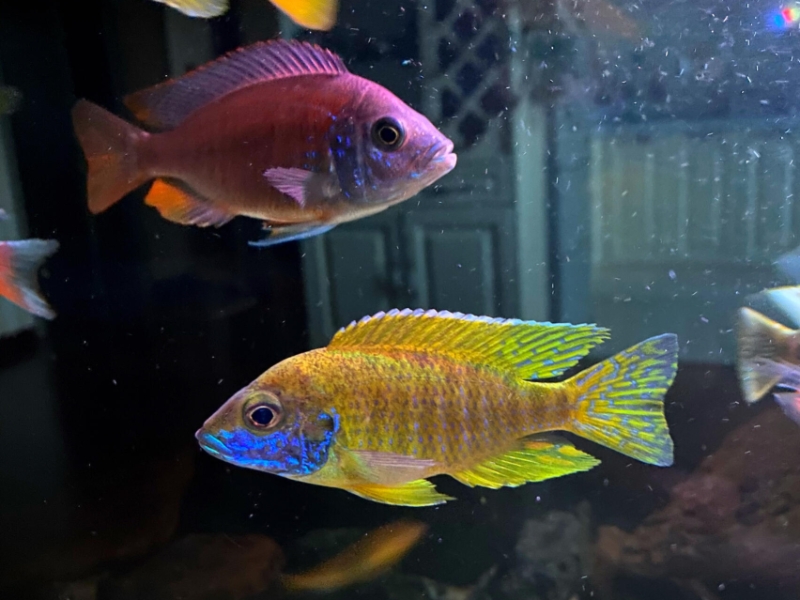
Common Health Issues (and How to Fix Them)
Even tough cichlids get sick sometimes. Here’s your cheat sheet:
1. “Ich” (White Spot Disease)
- Symptoms: Tiny white dots, flashing against rocks.
- Fix: Raise temp to 86°F for 3 days + aquarium salt (follow package instructions).
2. Bloat
- Symptoms: Swollen belly, not eating.
- Prevention: Avoid overfeeding and vary their diet.
3. Hole-in-the-Head Disease
- Causes: Poor diet or bad water quality.
- Fix: Improve nutrition (add vitamins) and do daily 10% water changes.
4. Fin Rot
- Signs: Ragged, discolored fins.
- Treatment: Clean water + antibacterial meds from your fish store.
Golden rule: Quarantine new fish for 2 weeks before adding them to your main tank!
FAQs: Quick Answers to Common Questions
Q: Can I keep African and South American cichlids together?
A: It’s risky. Their water needs clash, and Africans are usually more aggressive. Best to keep them separate.
Q: How long do cichlids live?
A: 5-10 years for most species. Oscars can hit 15+ with great care!
Q: Why is my cichlid digging pits in the gravel?
A: Totally normal! They’re building nests or just redecorating their territory.
Q: Do cichlids recognize their owners?
A: Many do! They’ll swim to the front glass when you approach – especially if you’re the food-bringer.
Final Tips for Happy Cichlids
- Patience pays: Let new tanks cycle fully before adding fish.
- Watch and learn: Every cichlid has quirks. Notice what makes yours thrive.
- Join a community: Local fish clubs or online forums are goldmines for advice.
Cichlids aren’t just pets – they’re personalities in your home. With the right setup and a little TLC, you’ll have a vibrant, active tank that’s pure joy to watch. Got questions? Drop them in the comments below, and happy fishkeeping!
Want More Fishkeeping Tips? Check Out These Guides!
👉 New to aquariums? Start with our list of the 10 Best Fish for Beginners: Easy-Care Species – perfect for stress-free setups!
👉 Summer tank getting too hot? Learn when and how to use an Aquarium Chiller Guide: Why You Need One & How to Choose to keep your cichlids cool and comfy.
Marine Biologist | Aquatech Innovator
Coral reef conservation, Water monitoring, marine biologist

